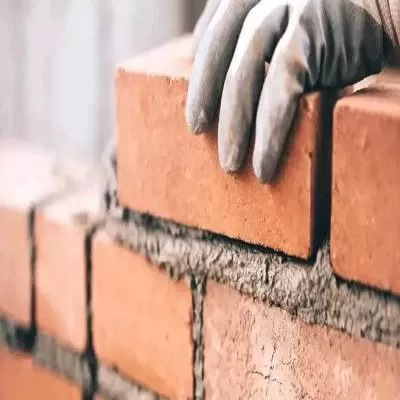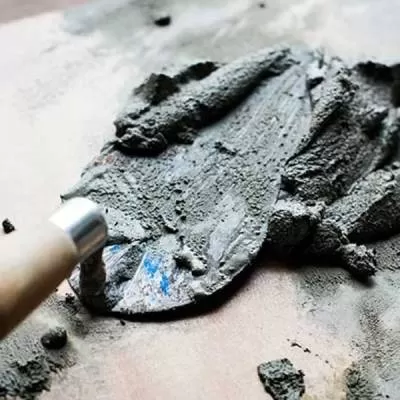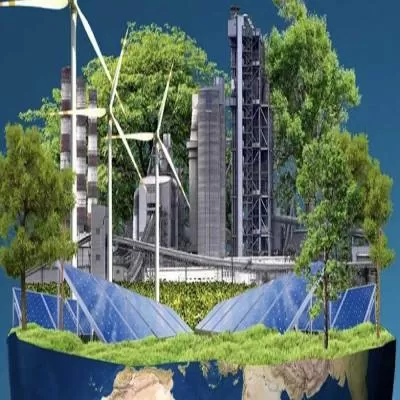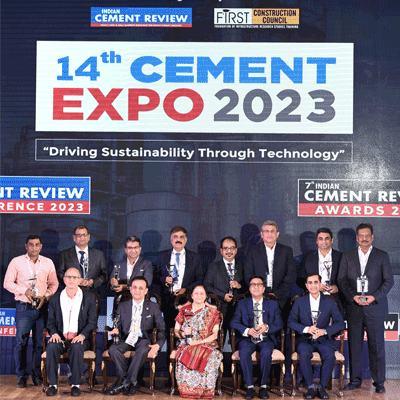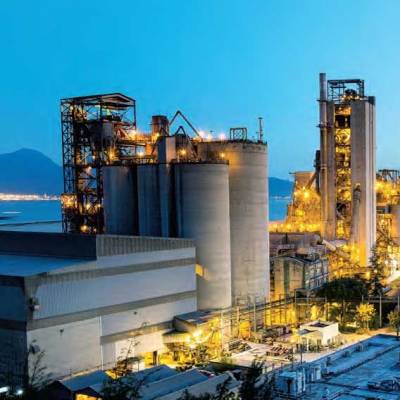- Home
- Building Material
- Cement
- Cementing Brands

Cementing Brands
In an all-India market that grew 1-6 per cent across regions due to challenging business conditions, leading cement companies delivered strong performances, with some even achieving 20 per cent growth last year.
These players are focused on improving their share as the opportunities they foresee unfold.
'Demand for cement is expected to grow at 7-8 per cent CAGR in the coming years, primarily led by increased consumption by the infrastructure and housing segments, says Rahul Akkara, Vice President-Strategy & Brand, JSW Cement.
We are positively cautious about the near term and optimistic about the medium and long term, in view of improved macro indicators for the economy, significant growth in public spending and focused execution plans,' says Mahendra Singhi, Group CEO, Dalmia Cement (Bharat), a company with well balanced capacity in the East (52 per cent) and South (48 per cent). In particular, Singhi expects a boost from the Central Government's thrust on affordable housing and infrastructure and development-focused state governments' plans.
Bullish markets
Genuine demand has picked up in the last two months, says K Ravi, Managing Director, NCL Industries, a predominantly South Indian player with 2 mtpa installed capacity running at 75 per cent capacity utilisation, which crossed Rs 1,000 crore turnover for the first time last year, growing at a 20 per cent. 'We expect cement to do well in the next two to three years, especially in the Andhra Pradesh market, which is recovering after the slump brought on by the state separation.'
'In Andhra Pradesh, irrigation and road projects and building the new capital, while in Telangana, irrigation and road projects, government sponsored affordable housing and the development of Hyderabad present enormous opportunities for cement demand,' according to M Ravinder Reddy, Director-Marketing, Bharathi Cement Corporation, Vicat Group.
'In Andhra Pradesh, cement demand will grow on the back of the Central Government incentivising the state government by exempting capital gains tax for land owners who offer their land under the land pooling mechanism,' says Singhi. Demand growth in the South is vital to boost capacity utilisation, Reddy feels. 'Our utilisation capacity is barely 50-60 per cent against the ideal 75-80 per cent.'
Apart from fair growth in the South as many infrastructure initiatives roll out, Akkara is of the opinion that the expanding infrastructure and slew of projects about to kick off in the next few years make the East a bullish market.
'We expect expansion in the cement industry in all geographic zones. However, it is likely that the East will see more cement growth as it is expected to see high development,' says Sailesh Mohta, President (Marketing), Wonder Cement.
JSW Group plans to tap these emerging opportunities by expanding its cement production capacity from 6 mtpa to 30 mtpa through new grinding units closer to its steel plants. 'Our new capacity will come up across major parts of the East and South to intensify our service leverage and product offering to clients in these regions,' says Akkara. 'Markets in major parts of the East have already evolved with Portland Slag Cement having 50 per cent share; and with our expansion in Salboni, Rourkela and Odisha, we will be able to make an inroad in the markets of West Bengal, Odisha, Jharkhand and parts of Bihar.'
As for the rest of the country, Akkara opines: 'So far, we have seen a rise in independent housing construction in semi-urban and rural areas majorly in Chennai, Kolkata, Punjab, Maharashtra, and Haryana. We anticipate strong demand from road and other government projects in these regions.'
Brand building
Brand building matters significantly in a market that is roughly two-thirds retail sales driven, with close to 100 brands competing across India despite consolidation bringing half of the installed capacity under the control of the top five players. For perspective, consider that two to three brands of cement dominate the market in most developed countries.
According to Reddy, 'Consolidation will make no difference to the multitude of brands in India; the market will continue to be occupied by international, national, regional and local brands, these co-exist because the market is genuinely large and populated by buyers for each kind. If some brands consolidate, new ones will emerge.'
However, Mohta is of the opinion that consolidation has reduced the number of brands available somewhat, and improved the product quality, such that most of the existing brands offer a fairly standardised product, which in turn, helps customers.
Brand building is even more being reflected in increased product advertising and media engagement. 'At Dalmia, where building strong brand value is an ongoing commitment, the launch of Dalmia DSP super premium cement in the East, South and North East has necessitated an increase in advertising spending,' says Singhi.
Premium cement
A strong brand goes hand in hand with premium products and premium pricing, and spurs retail trade. 'In coastal Andhra, one of our predominant markets, we command Rs 5-10 premium over the prices of other national leading players,' says Ravi. 'We do not approach builders or institutions to sell cement because they call for tenders and adopt the lowest, whereas our strategy has been to build a strong brand the end consumer is willing to pay extra for.'
Customers are turning to premium quality cement for 'higher grade of concrete,' says Samar Ghoshdastidar, Technical Director, Simplex Infrastructures. 'We have used M95 grade concrete for constructing a tall residential building in Mumbai, Maharashtra. We also use OPC 53 premium grade cement and other kinds of cement as the project requires. For instance, we use sulphate-resistant cement for installing piles in aggressive soil conditions to protect against harmful chemicals. Overall, our decision to buy cement is influenced by the suppliers' reputation, the cement quality, the proximity of the suppliers unit (to reduce transportation), the quoted rates, payment terms, etc.'
'At Omkar, we use premium cement for all our projects be it mid-size, high-rise or our rehab towers,' says Raman Sapru, President-EPC, Omkar Realtors & Developers. 'We never compromise on quality, procure and use branded products, even cement for our buildings. ACC and Ambuja produce good quality cement for construction.'
Government supply
Government plans to revive state-run cement factories across India aim at giving a boost to road and realty projects by bringing down construction costs. The big questions are: Will the revival happen, and if so, will it impact private players?
Precast Industry Challenges
Fluctuating prices of basic raw materials like cement, steel, sand and aggregates cause delays in the construction of precast structures and slowdown adoption, opines M Karthik, Director, VME Precast.
Low government pricing for affordable housing is another barrier to the adoption of precast technology. 'It is ironical that precast is seen as an ideal construction model for affordable housing, a key government priority, for enabling fast construction, but, applying this technology at the current low government rates for affordable housing projects is unviable,' says Karthik.
'Excise duty makes the precast product costlier than cast in-situ, putting off potential takers,' says CA Prasad, Director, Metey Engineering & Consultancy. 'Other challenges include the high set up cost of a precast unit and its payback period, the overall viability of precast, few entrepreneurs in the sector, low precast awareness and resistance to change among developers.'
'Since 98 per cent of the total installed capacity is with the private sector, reviving the idle capacity with the public sector will be a small help,' says Mohta.
'In states such as Telangana, where the Cement Corporation of India has barely 1.3 mtpa of the 200 mtpa overall installed capacity, 1.0 mtpa in a functioning plant and 0.3 mtpa in a closed plant, the reopening of the shut plant will not make a difference to the prospects of private players.
Also, the Tamil Nadu cluster, which already has a functional government-run plant, would see no change,' opines Reddy.
Clearly, the impact will depend on the installed and operational capacity in each market.
Price fluctuation
Of late, cement price fluctuations are an outcome of the competitive play between brands as well as due to the increase in raw material costs, pet coke fuel costs and logistics and wage rate hikes, according to Reddy. 'Last year, input costs were low and manufacturers were able to keep prices low.' Some price fluctuation may also be attributed to the trend in trade vs non-trade sales of cement, says Akkara. 'Trade cement sales by dealers are priced higher than non-trade cement sales directly to consumers, mainly institutional buyers.'
Cement price fluctuation in turn adversely impacts the prospects and adoption of precast technology.
Precast prospects
Major developers have adopted precast technology for faster project completion, to circumvent labour shortages and achieve quality construction with less wastage. 'Precast construction requires one tenth of the labour requirement of cast in-situ construction,' observes CA Prasad, Director, Metey Engineering & Consultancy. 'In South India, information technology companies such as Infosys and Estancia IT Park are implementing precast commercial projects,' says M Karthik, Director, VME Precast. 'L&T, Brigade and Puravankara are implementing high-end residential projects in Bengaluru; L&T also has a mixed-use project in the city.'
Janapriya Developers, Hyderabad; Supertech, Noida; Sobha Developers, Bengaluru; Bharat City Developers, Ghaziabad; and others, have adopted precast, while the key precast element suppliers include PRECA, Hyderabad; VME Precast, Chennai; Teemage Precast, Coimbatore; KEF, Bengaluru; and India Precast, Pune; according to Prasad. 'A big positive is the housing boards of Chhattisgarh, Odisha, Bengaluru, Andhra Pradesh and Madhya Pradesh calling for tenders proposing only precast technology.' In the infrastructure segment, metro constructions are predominantly using precast elements, says Prasad. 'We cast all sorts of elements based on the project requirement, such as the girder segments of elevated metro projects, flyover projects and units for marine projects,' says Ghoshdastidar.
QUICK BYTES
- Demand drivers: Increased consumption by infrastructure and housing.
- In infra, metro constructions are predominantly using precast elements.
- Demand growth in the South is vital to boost cement capacity utilisation.
What Cement Makers Want?
Cement as a commodity is highly dependent upon the reach of the company's distribution network. In fact, location plays such a critical role in the cement industry that several companies have become regional players due to high freight costs, says Mahendra Singhi, Group CEO, Dalmia Cement (Bharat).
Given the high transportation costs and challenging logistics, initiatives to make road movement seamless would go a long way to smooth operations, says K Ravi, Managing Director, NCL Industries.
Also, cement should be considered at par with steel and other core sectors, and the high and variable taxes across different states should be rationalised, according to Ravi, who expects cement taxation to improve with the launch of GST.
Precast Industry Challenges
Fluctuating prices of basic raw materials like cement, steel, sand and aggregates cause delays in the construction of precast structures and slowdown adoption, opines M Karthik, Director, VME Precast.
Low government pricing for affordable housing is another barrier to the adoption of precast technology. 'It is ironical that precast is seen as an ideal construction model for affordable housing, a key government priority, for enabling fast construction, but, applying this technology at the current low government rates for affordable housing projects is unviable,' says Karthik.
'Excise duty makes the precast product costlier than cast in-situ, putting off potential takers,' says CA Prasad, Director, Metey Engineering & Consultancy. 'Other challenges include the high set up cost of a precast unit and its payback period, the overall viability of precast, few entrepreneurs in the sector, low precast awareness and resistance to change among developers.'
- Charu Bahri
To share your insights on the market for Cement and Precast, write in at feedback@ConstructionWorld.in
Premium offerings go with brand building, the current focus of the Indian cement industry. In an all-India market that grew 1-6 per cent across regions due to challenging business conditions, leading cement companies delivered strong performances, with some even achieving 20 per cent growth last year. These players are focused on improving their share as the opportunities they foresee unfold. 'Demand for cement is expected to grow at 7-8 per cent CAGR in the coming years, primarily led by increased consumption by the infrastructure and housing segments, says Rahul Akkara, Vice President-Strategy & Brand, JSW Cement. We are positively cautious about the near term and optimistic about the medium and long term, in view of improved macro indicators for the economy, significant growth in public spending and focused execution plans,' says Mahendra Singhi, Group CEO, Dalmia Cement (Bharat), a company with well balanced capacity in the East (52 per cent) and South (48 per cent). In particular, Singhi expects a boost from the Central Government's thrust on affordable housing and infrastructure and development-focused state governments' plans. Bullish markets Genuine demand has picked up in the last two months, says K Ravi, Managing Director, NCL Industries, a predominantly South Indian player with 2 mtpa installed capacity running at 75 per cent capacity utilisation, which crossed Rs 1,000 crore turnover for the first time last year, growing at a 20 per cent. 'We expect cement to do well in the next two to three years, especially in the Andhra Pradesh market, which is recovering after the slump brought on by the state separation.' 'In Andhra Pradesh, irrigation and road projects and building the new capital, while in Telangana, irrigation and road projects, government sponsored affordable housing and the development of Hyderabad present enormous opportunities for cement demand,' according to M Ravinder Reddy, Director-Marketing, Bharathi Cement Corporation, Vicat Group. 'In Andhra Pradesh, cement demand will grow on the back of the Central Government incentivising the state government by exempting capital gains tax for land owners who offer their land under the land pooling mechanism,' says Singhi. Demand growth in the South is vital to boost capacity utilisation, Reddy feels. 'Our utilisation capacity is barely 50-60 per cent against the ideal 75-80 per cent.' Apart from fair growth in the South as many infrastructure initiatives roll out, Akkara is of the opinion that the expanding infrastructure and slew of projects about to kick off in the next few years make the East a bullish market. 'We expect expansion in the cement industry in all geographic zones. However, it is likely that the East will see more cement growth as it is expected to see high development,' says Sailesh Mohta, President (Marketing), Wonder Cement. JSW Group plans to tap these emerging opportunities by expanding its cement production capacity from 6 mtpa to 30 mtpa through new grinding units closer to its steel plants. 'Our new capacity will come up across major parts of the East and South to intensify our service leverage and product offering to clients in these regions,' says Akkara. 'Markets in major parts of the East have already evolved with Portland Slag Cement having 50 per cent share; and with our expansion in Salboni, Rourkela and Odisha, we will be able to make an inroad in the markets of West Bengal, Odisha, Jharkhand and parts of Bihar.' As for the rest of the country, Akkara opines: 'So far, we have seen a rise in independent housing construction in semi-urban and rural areas majorly in Chennai, Kolkata, Punjab, Maharashtra, and Haryana. We anticipate strong demand from road and other government projects in these regions.' Brand building Brand building matters significantly in a market that is roughly two-thirds retail sales driven, with close to 100 brands competing across India despite consolidation bringing half of the installed capacity under the control of the top five players. For perspective, consider that two to three brands of cement dominate the market in most developed countries. According to Reddy, 'Consolidation will make no difference to the multitude of brands in India; the market will continue to be occupied by international, national, regional and local brands, these co-exist because the market is genuinely large and populated by buyers for each kind. If some brands consolidate, new ones will emerge.' However, Mohta is of the opinion that consolidation has reduced the number of brands available somewhat, and improved the product quality, such that most of the existing brands offer a fairly standardised product, which in turn, helps customers. Brand building is even more being reflected in increased product advertising and media engagement. 'At Dalmia, where building strong brand value is an ongoing commitment, the launch of Dalmia DSP super premium cement in the East, South and North East has necessitated an increase in advertising spending,' says Singhi. Premium cement A strong brand goes hand in hand with premium products and premium pricing, and spurs retail trade. 'In coastal Andhra, one of our predominant markets, we command Rs 5-10 premium over the prices of other national leading players,' says Ravi. 'We do not approach builders or institutions to sell cement because they call for tenders and adopt the lowest, whereas our strategy has been to build a strong brand the end consumer is willing to pay extra for.' Customers are turning to premium quality cement for 'higher grade of concrete,' says Samar Ghoshdastidar, Technical Director, Simplex Infrastructures. 'We have used M95 grade concrete for constructing a tall residential building in Mumbai, Maharashtra. We also use OPC 53 premium grade cement and other kinds of cement as the project requires. For instance, we use sulphate-resistant cement for installing piles in aggressive soil conditions to protect against harmful chemicals. Overall, our decision to buy cement is influenced by the suppliers' reputation, the cement quality, the proximity of the suppliers unit (to reduce transportation), the quoted rates, payment terms, etc.' 'At Omkar, we use premium cement for all our projects be it mid-size, high-rise or our rehab towers,' says Raman Sapru, President-EPC, Omkar Realtors & Developers. 'We never compromise on quality, procure and use branded products, even cement for our buildings. ACC and Ambuja produce good quality cement for construction.' Government supply Government plans to revive state-run cement factories across India aim at giving a boost to road and realty projects by bringing down construction costs. The big questions are: Will the revival happen, and if so, will it impact private players? Precast Industry Challenges Fluctuating prices of basic raw materials like cement, steel, sand and aggregates cause delays in the construction of precast structures and slowdown adoption, opines M Karthik, Director, VME Precast. Low government pricing for affordable housing is another barrier to the adoption of precast technology. 'It is ironical that precast is seen as an ideal construction model for affordable housing, a key government priority, for enabling fast construction, but, applying this technology at the current low government rates for affordable housing projects is unviable,' says Karthik. 'Excise duty makes the precast product costlier than cast in-situ, putting off potential takers,' says CA Prasad, Director, Metey Engineering & Consultancy. 'Other challenges include the high set up cost of a precast unit and its payback period, the overall viability of precast, few entrepreneurs in the sector, low precast awareness and resistance to change among developers.' 'Since 98 per cent of the total installed capacity is with the private sector, reviving the idle capacity with the public sector will be a small help,' says Mohta. 'In states such as Telangana, where the Cement Corporation of India has barely 1.3 mtpa of the 200 mtpa overall installed capacity, 1.0 mtpa in a functioning plant and 0.3 mtpa in a closed plant, the reopening of the shut plant will not make a difference to the prospects of private players. Also, the Tamil Nadu cluster, which already has a functional government-run plant, would see no change,' opines Reddy. Clearly, the impact will depend on the installed and operational capacity in each market. Price fluctuation Of late, cement price fluctuations are an outcome of the competitive play between brands as well as due to the increase in raw material costs, pet coke fuel costs and logistics and wage rate hikes, according to Reddy. 'Last year, input costs were low and manufacturers were able to keep prices low.' Some price fluctuation may also be attributed to the trend in trade vs non-trade sales of cement, says Akkara. 'Trade cement sales by dealers are priced higher than non-trade cement sales directly to consumers, mainly institutional buyers.' Cement price fluctuation in turn adversely impacts the prospects and adoption of precast technology. Precast prospects Major developers have adopted precast technology for faster project completion, to circumvent labour shortages and achieve quality construction with less wastage. 'Precast construction requires one tenth of the labour requirement of cast in-situ construction,' observes CA Prasad, Director, Metey Engineering & Consultancy. 'In South India, information technology companies such as Infosys and Estancia IT Park are implementing precast commercial projects,' says M Karthik, Director, VME Precast. 'L&T, Brigade and Puravankara are implementing high-end residential projects in Bengaluru; L&T also has a mixed-use project in the city.' Janapriya Developers, Hyderabad; Supertech, Noida; Sobha Developers, Bengaluru; Bharat City Developers, Ghaziabad; and others, have adopted precast, while the key precast element suppliers include PRECA, Hyderabad; VME Precast, Chennai; Teemage Precast, Coimbatore; KEF, Bengaluru; and India Precast, Pune; according to Prasad. 'A big positive is the housing boards of Chhattisgarh, Odisha, Bengaluru, Andhra Pradesh and Madhya Pradesh calling for tenders proposing only precast technology.' In the infrastructure segment, metro constructions are predominantly using precast elements, says Prasad. 'We cast all sorts of elements based on the project requirement, such as the girder segments of elevated metro projects, flyover projects and units for marine projects,' says Ghoshdastidar. QUICK BYTES Demand drivers: Increased consumption by infrastructure and housing. In infra, metro constructions are predominantly using precast elements. Demand growth in the South is vital to boost cement capacity utilisation. What Cement Makers Want? Cement as a commodity is highly dependent upon the reach of the company's distribution network. In fact, location plays such a critical role in the cement industry that several companies have become regional players due to high freight costs, says Mahendra Singhi, Group CEO, Dalmia Cement (Bharat). Given the high transportation costs and challenging logistics, initiatives to make road movement seamless would go a long way to smooth operations, says K Ravi, Managing Director, NCL Industries. Also, cement should be considered at par with steel and other core sectors, and the high and variable taxes across different states should be rationalised, according to Ravi, who expects cement taxation to improve with the launch of GST. Precast Industry Challenges Fluctuating prices of basic raw materials like cement, steel, sand and aggregates cause delays in the construction of precast structures and slowdown adoption, opines M Karthik, Director, VME Precast. Low government pricing for affordable housing is another barrier to the adoption of precast technology. 'It is ironical that precast is seen as an ideal construction model for affordable housing, a key government priority, for enabling fast construction, but, applying this technology at the current low government rates for affordable housing projects is unviable,' says Karthik. 'Excise duty makes the precast product costlier than cast in-situ, putting off potential takers,' says CA Prasad, Director, Metey Engineering & Consultancy. 'Other challenges include the high set up cost of a precast unit and its payback period, the overall viability of precast, few entrepreneurs in the sector, low precast awareness and resistance to change among developers.' - Charu Bahri To share your insights on the market for Cement and Precast, write in at feedback@ConstructionWorld.in


